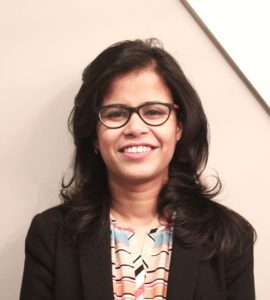 Our Six Questions series spotlights the work of Social Media and Democracy Research Grantees. This month, we bring you an interview with the principal investigator of Virginia Tech’s research team, Dr. Tanushree Mitra. Along with her team of Virginia Tech Department of Computer Science scholars, Dr. Mitra will investigate differences in the way Facebook users share mainstream and nonmainstream news.
Our Six Questions series spotlights the work of Social Media and Democracy Research Grantees. This month, we bring you an interview with the principal investigator of Virginia Tech’s research team, Dr. Tanushree Mitra. Along with her team of Virginia Tech Department of Computer Science scholars, Dr. Mitra will investigate differences in the way Facebook users share mainstream and nonmainstream news.
Six Questions: Characterizing Mainstream and Nonmainstream Online News Sources in Social Media
Tanushree Mitra, Assistant Professor, Department of Computer Science at Virginia Tech
What trends have you seen in your research on social media?
In my research on the spread of conspiracy theories online, I’ve found that the amount of mainstream news coverage of shocking events triggers a proportional rise in online conspiracy theories. For example, directly following the 2014 Malaysia Airlines crash—about which there was a lot of news coverage—there was a huge influx of new conspiracy theorists on online platforms, particularly Reddit. We’ve also found the same trends following mass shooting events like Parkland and Sandy Hook.
What changes have you seen in the way news is shared in social media?
News outlets are no longer the only distributors of news. Many people now use social media platforms like Twitter and Facebook as their primary news sources instead of paying for newspapers or magazines. As a result of this trend and accusations of political bias, we’ve seen an increase in reactionary platforms that cater to specific viewpoints.
What are the core questions your research hopes to address?
Due to the low marginal cost of online information exchange, we have witnessed the emergence of a vast number of news outlets that disseminate information, ranging from carefully vetted news to completely fabricated rumors. The proliferation of such nontraditional bogus news sources has resulted in an environment where any claim can gain legitimacy as reliable news and any information outlet can be deemed a credible news source. How can we differentiate fabricated news outlets from mainstream legitimate news sources? This is the core question that our research hopes to answer.
What outcomes are you expecting to see from your research?
In the short term, we are expecting to lay out the distinct characteristics of fabricated news sources, find significant differences in the linguistic styles, and in the way people interact with fabricated news as opposed to mainstream sources on social media, specifically on Facebook. We’ve already noticed that some illegitimate websites tend to use more emotionally charged words when reporting content on social media platforms. The next step is observing how users respond to this content by analyzing data including likes and shares, and how user interactions evolve over time. Over the long term, we hope our understanding will help us devise tools that can automatically or semi-automatically detect a website’s legitimacy.
What previous research does your current research draw on?
In 2014, we looked into how journalists shared content on Twitter. Until then, there wasn’t much consideration or data on journalists using social media platforms for news reporting. So this work was our first foray into analyzing the ways journalists used Twitter to distribute news. At the time, tweets were limited to 140 characters, so they had to tweet efficiently. Because of this character restriction, the ways journalists reported content followed very specific patterns. This was perfect for running algorithms, and we were able to build a computational model using that data to find out how reporters use online platforms to put forth certain claims. That analysis was really important in understanding the key characteristics of legitimate online news reporting done by professional journalists, and we’re glad we can bring work we did years ago back into this project.
What’s next?
There’s another issue concerning how expert fact checkers evaluate content, which is a really important component we haven’t been able to access earlier. Facebook’s data sharing partnership provides a glimpse into articles that have been marked as false or credible by professional fact checkers. What do fact checkers consider to be credible? What do they consider factual? What processes do they follow in making these determinations? And with this information, how can we build a workflow where the public can work in sync with fact checkers to better annotate online news and information and how can they do so at scale? In my utopian vision of the future, we won’t need the scaffolding of fact checking experts for assessing every piece of online information, rather the public themselves would be better equipped to fact check on their own.
For more information on the Social Media and Democracy Research Grants, please visit the program page.












